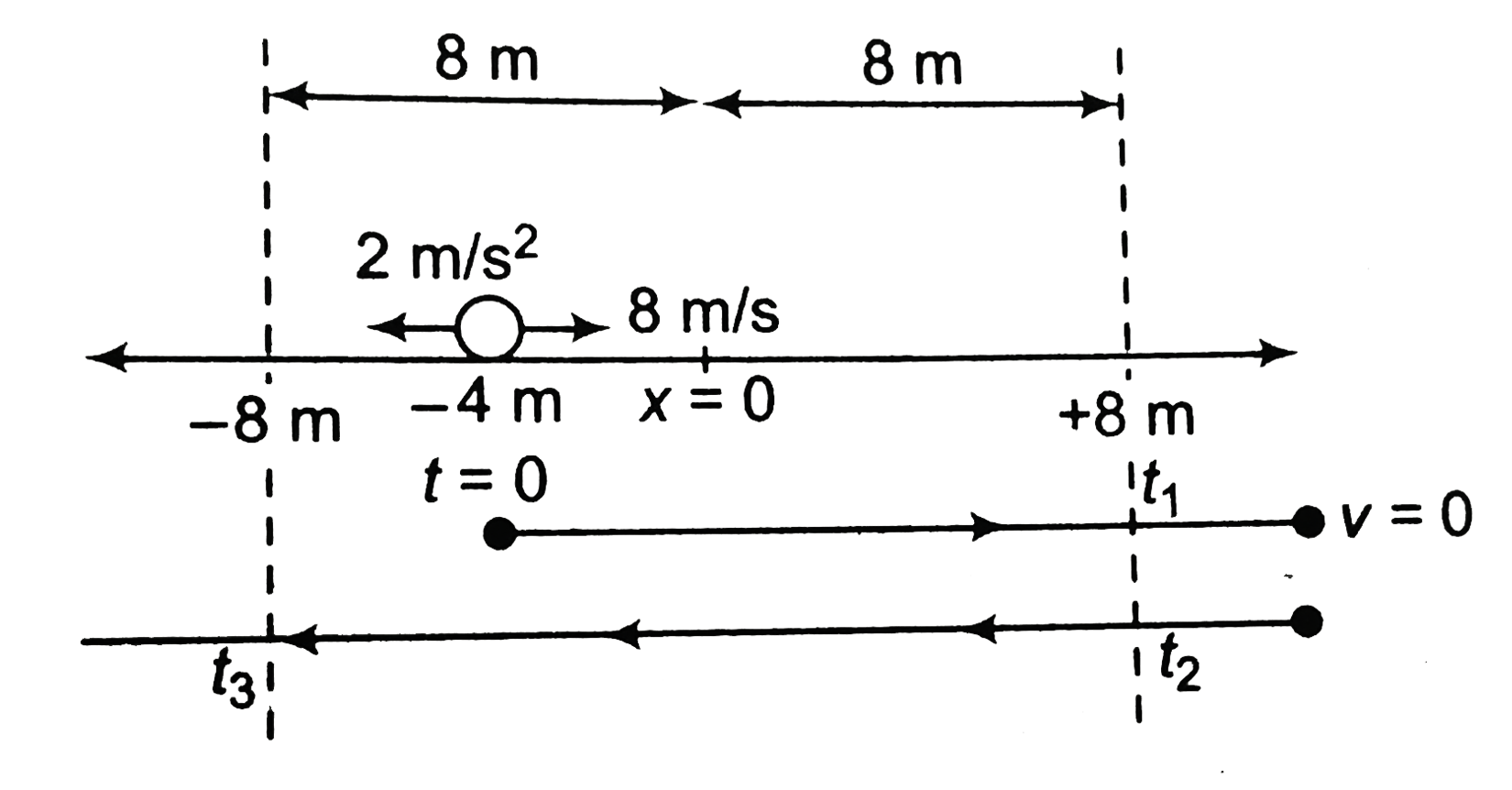A particle is moving along x-axis. At time t=0, Its x-coordinate is x=−4m. Its velocity-time equation is v=8−2t where, v is in m//s and t in seconds.
(a) At how many times, particle is at a distance of 8m from the origin?
(b) Find those times.
The correct Answer is:A, B, C, D
(a) Comparing the given v-t equation with v=u+at. we have,
u=8m/s and
a=−2m/s2=constant
Now, motion of the particle is as shown below. 
Now, 8m distance from origin will be at two coordinates x=8mandx=−8m. From the diagram, we can see that particle will cross these two points three times, t1,t2,andt3.
(b) t1 and t2: At x=8m displacement from the strating point is
s=xf−xi=8−(4)=12m
Substituting in s=ut+12at2, we have
12=8t−12×2×t2
Solving this equation, we get
smaller time t1=2s
and larger time t2=6s
t3: At x=−8m, displacement from the starting point is
s=xf−xi=−8−(−4)=−4m
Substituting in s=ut+12at2, we have −4=8t−12×2×t2
Solving this equation, we get the positive time,
t3=8.47s
Topper's Solved these Questions
- KINEMATICSBOOK - DC PANDEYCHAPTER - KINEMATICSEXERCISE - Miscellaneous Example
12 Videos
- KINEMATICSBOOK - DC PANDEYCHAPTER - KINEMATICSEXERCISE - Exercise 6.1
2 Videos
- KINEMATICSBOOK - DC PANDEYCHAPTER - KINEMATICSEXERCISE - Example Type 6
1 Videos
- GRAVITATIONBOOK - DC PANDEYCHAPTER - GRAVITATIONEXERCISE - (C) Chapter Exercises
45 Videos
- KINEMATICS 1BOOK - DC PANDEYCHAPTER - KINEMATICS 1EXERCISE - INTEGER_TYPE
15 Videos
Similar Questions
A particle is moving along x-axis. Its X-coordinate varies with time as, X=2t2+4t−6 Here, X is in meters and t in seconds. Find average velocity between the time interval t=0→t=2s.
View SolutionA particle in moving in a straight line such that its velocity is given by v=12t−3t2, where v is in m//s and t is in seconds. If at =0, the particle is at the origin, find the velocity at t=3s.
View Solution
Knowledge Check
A particle is travelling along X-axis and its x-coordinate is related to time as follows:
x=5t2−20
Here x is measured in metres and time t in seconds.
When does the particle cross the origin?A2sB3sC1sDneverA particle is moving along X-axis Its acceleration at time t is proportional to its velocity at that time. The differential equation of the motion of the particle is
Ad2xdt2−kdxdt=0,k>0Bd2xdt2+kdxdt=0,k>0Cd2xdt2−k=0,k>0Dd2xdt2+k=0,k>0Velocity of particle moving along positive x-direction is v=(40−10t)m/s. Here,t is in seconds. At time t=0, tha x coordinate of particle is zero. Find the time when the particle is at a distance of 60 m from origin.
At3=2(1+√7)sBt3=2(2+√7)sCt3=2(2+√9)sDt3=√7)s
Acceleration of particle moving along the x-axis varies according to the law a=−2v, where a is in m/s2 and v is in m/s. At the instant t=0, the particle passes the origin with a velocity of 2m/s moving in the positive x-direction.
(a) Find its velocity v as function of time t.
(b) Find its position x as function of time t.
(c) Find its velocity v as function of its position coordinates.
(d) find the maximum distance it can go away from the origin.
(e) Will it reach the above-mentioned maximum distance?
View SolutionA particle moves along the X-axis. Its X-coordinate varies with time according to the expression x=4t+2r2, where x is in meters and t is in seconds. The position-time graph for this motion is shown in the figures previously. Note that the particle moves in the negative X-direction for the first second of motion, is at rest at the moment t=1s, and then heads back in the positive X-direction for t>1s.
Find the displacement of the particle in the time interval t=0 s to t=1 s.
View SolutionA particle moves along the X-axis. Its X-coordinate varies with time according to the expression x=4t+2r2, where x is in meters and t is in seconds. The position-time graph for this motion is shown in the figures previously. Note that the particle moves in the negative X-direction for the first second of motion, is at rest at the moment t=1s, and then heads back in the positive X-direction for t>1s.
Find the displacement of the particle in the time interval t=1sto t=3s.
View SolutionA particle moves along the X-axis. Its X-coordinate varies with time according to the expression x=4t+2r2, where x is in meters and t is in seconds. The position-time graph for this motion is shown in the figures previously. Note that the particle moves in the negative X-direction for the first second of motion, is at rest at the moment t=1s, and then heads back in the positive X-direction for t>1s.
Find the instantaneous velocity of the particle at t=2.5s.
View SolutionAcceleration of a particle moving along the x-axis is defined by the law a=−4x, where a is in m/s2 and x is in meters. At the instant t=0, the particle passes the origin with a velocity of 2m/s moving in the positive x-direction.
(a) Find its velocity v as function of its position coordinates.
(b) find its position x as function of time t.
(c) Find the maximum distance it can go away from the origin.
View Solution
